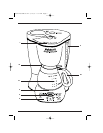
5
THE QUEST FOR
THE PERFECT CUP
OF COFFEE
It is generally agreed that there are four basic
elements critical to the perfect cup:
Element 1: Water
Coffee is 98% water. Often overlooked, the
quality of the water is as important as the
quality of the coffee. If you filter your drinking
water, filter the water for your coffeemaker.
A good rule of thumb is that if your water
doesn’t taste good from the tap, it won’t taste
any better in your coffee.
For hard water areas, we recommend using
bottled water. The calcium in the water and
the softeners used to combat it have a major
impact on the extraction of the coffee. Hard
water will also accelerate calcium buildup
inside the coffeemaker which, in turn, slows
down brewing, affects the flavor of the
coffee, and ultimately may shorten the life
of your coffeemaker.
Element 2: Coffee
While the bulk of the liquid is water, all of the
flavor should be from the coffee. To achieve
the same great quality cup of coffee you
receive at a coffee bar, you need to use the
same quality beans.
Buy the beans fresh and whole, only about
two weeks’ supply at a time for maximum
freshness. Once the coffee bean is broken, its
flavor degrades very quickly. That’s why the
Automatic Grind & Brew
™
grinds your coffee
just prior to brewing. If it is not practical to buy
small supplies, we recommend you separate
larger amounts of beans into one to two week
portions immediately after purchase, and
freeze them in airtight containers. The best
way to maximize freshness is to minimize
exposure to air, light and moisture. So, once
beans have been removed from the freezer,
maintain them in a sealed container at room
temperature, since damaging condensation
occurs every time the beans are removed from
the freezer or refrigerator. Note that some cof-
fee experts advise against freezing dark-roast
beans, because freezing can cause the oils to
coagulate. Other experts disagree. We suggest
you experiment and decide for yourself.
Element 3: Grind
The grind is critical for proper flavor extraction.
If the grind is too fine, overextraction and bit-
terness will result. Too fine a grind may also
clog the filter. If grind is too coarse, the water
will pass through too quickly and the desired
flavors will not be extracted. The Automatic
Grind & Brew
™
is preset for a medium grind,
the optimal grind for this type of coffeemaker.
Element 4: Proportion
The Automatic Grind & Brew
™
makes up to ten
(10) 5-ounce cups of coffee.
Using Whole Beans:
• To make a full pot of coffee:
Fill the grinder basket to the top.
DO NOT OVERFILL OR THE GRINDER
COULD MALFUNCTION.
• To make fewer than 10 cups of coffee:
We recommend you use about 1 tablespoon
of whole beans per cup. Note: One
measuring scoop is approximately equal
to one tablespoon. For 1 or 2 cups, use
1-1/2 tablespoons per cup. Adjust the recipe
according to individual taste.
Using Pre-Ground Coffee:
Although it is preferable to use fresh, whole
beans, you can make coffee in the Automatic
Grind & Brew
™
using pre-ground beans.
To do so, turn off the grinder by pressing the
“Grind Off” button before turning on the unit.
Our recipe:
We suggest that you use 1 to 1 1/2 table-
spoons of ground coffee per cup. Note: One
measuring scoop is approximately equal
to one tablespoon. Adjust the recipe to
your taste.
NOTE: The maximum capacity for ground
coffee is 15 tablespoons, using either a
paper or permanent filter. Exceeding this
amount may cause overflow if the coffee is
too finely ground.
02CU13488 DGB300 IB 6/23/03 2:31 PM Page 5


















